a complete range of plastic and smartcard production services.
Contactless smart cards use radio frequency identification (RFID) technology to wirelessly communicate with a card reader. A copper or aluminum antenna is connected to an integrated circuit (chip) and then securely laminated inside the plastic card body under high heat and pressure. Contactless smart cards range from simple memory cards with low security and non-volatile memory structure up to high security crypto-processor cards and Java / Native operating system (OS) cards. Cardzgroup uses specialty formulated PVC and PET that allows us to manufacture the thinnest ISO contactless cards while eliminating the antenna and chip blemish found on many lower quality smart cards.
Worldwide adoption of contactless smart card technology has increased dramatically in the last decade due to the speed and convenience of RFID cards in education, identification, retail and transportation sectors. Contactless smart cards come in three distinct frequency ranges:
125khz Low Frequency Cards (LF)

Low frequency smart cards are predominantly used in identification and access control applications. LF cards have lower read range and communication speeds than other contactless smart card types and the most common chips offer low-cost and low-security solutions where a simple UID or identification key is required. Due to the shape of their waves, LF cards are less affected by other radio signals and materials in the environment such as water or metal which makes them a reliable choice in industrial environments. Common 125khz / 134khz cards offered by Cardzgroup include:
EM4100 / EM4200: Simple read-only chip with 128 bit factory programmed UID used in access control, anti-counterfeiting and logistics.
TK4100: Simple read-only chip with 128 bit factory programmed UID used in access control, anti-counterfeiting and logistics.
EM4450 / EM4550: Read/Write chip with 1Kbit EEPROM and password protection used in ticketing, access control and prepayment devices.
ATA5577 / T5577: Read/write chip with 363bit EEPROM and write protection, used in access control, hotel keycards, logistics and gaming.
Hitag 1: Read/Write chip with 2Kbit EEPROM used in logistics, asset tracking, industrial ID and automation.
Hitag 2: Read/Write chip with protected 256bit EEPROM and multi-tag operability used in logistics, asset tracking, casino gaming and industrial automation.
Hitag S: Read/Write chip based on Hitag 1 available in 256bit and 2048bit options used in logistics, asset tracking, brand protection and automation.
13.56Mhz High Frequency Cards (HF)
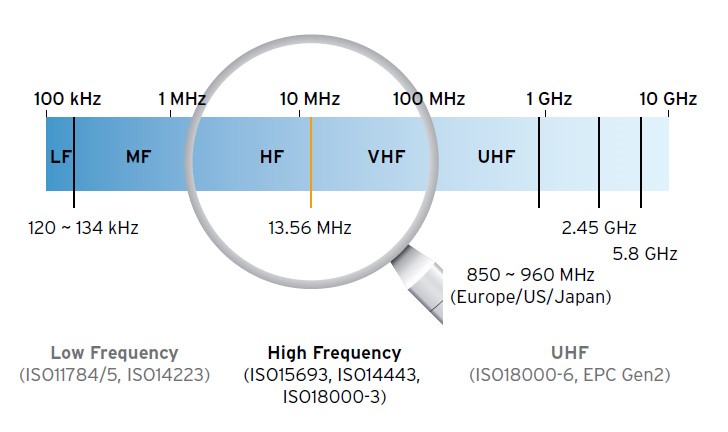
High frequency is the most diverse category of contactless and RFID smart card and is used extensively for college / university ID cards, in access control and identification, as retail payments and loyalty cards, and in transport and ticketing. 13.56Mhz HF cards are covered by ISO/IEC 14443A/B or ISO/IEC 15693 standards and range from simple fixed memory to high security Java and PKI processor cards. With medium read range and high data communication speeds, HF cards - often referred to as "vicinity cards" - are the go to choice for applications that require secure communication and large amounts of data to be shared between card and reader. Common 13.56Mhz cards offered by Cardzgroup include:
MIFARE® / MIFARE DESFire® : Click here for full MIFARE / MIFARE DESFire product list
Icode SLI: ISO 15693 chip with 1024bit EEPROM and password protected read/write.
Icode SLI-S: ISO 15693 chip with 1280bit EEPROM and password protected read/write.
Icode SLI-X: ISO 15693 chip with 896bit EEPROM.
Icode SLI-X2: ISO 15693 chip with 2528bit EEPROM and password protected read/write and 16bit counter.
SRT512: ISO 14443B chip with 512bit EEPROM and write protection.
SRi512: ISO 14443B chip with 512bit EEPROM including 160bit OTP memory and write protection.
SRi2k: ISO 14443B chip with 2048bit EEPROM including 160bit OTP memory and write protection.
SRi4k: ISO 14443B chip with 4096bit EEPROM including 160bit OTP memory and write protection.
SRiX4k: ISO 14443B chip with 4096bit EEPROM including 160bit OTP memory and write protection and proprietary anti-cloning tech.
LRi1K: ISO 15693 chip with 1024bit EEPROM and high (up to 1.5m) read range.
LRi2K: ISO 15693 chip with 2048bit EEPROM and high (up to 1.5m) read range.
LRiS2K: ISO 15693 chip with 2048bit EEPROM plus password protection and high (up to 1.5m) read range.
LRiS64K: ISO 15693 chip with 65536bit EEPROM plus password protection and high (up to 1.5m) read range.
Texas Instruments TI Tag-it HF-I: ISO 15693 chip with 64bit factory-programmed UID and 256bit EEPROM user programmable memory.
Texas Instruments TI Tag-it HF-I Plus: ISO 15693 chip with 64bit factory-programmed UID and 2048bit EEPROM user programmable memory.
Texas Instruments TI Tag-it HF-I Pro: ISO 15693 chip with 64bit factory-programmed UID and 256bit EEPROM user programmable memory including password write/password kill function.
Legic Prime MIM256: ISO 14443"F" chip with 256byte EEPROM and proprietary Legic RF protocol.
Legic Prime MIM1024: ISO 14443"F" chip with 1024byte EEPROM and proprietary Legic RF protocol.
Infineon my-d vicinity SRF 55V02P: ISO 15693 and ISO 18000-3 chip with 2.5Kbit EEPROM and both plain and secure modes.
Infineon my-d vicinity SRF 55V10P: ISO 15693 and ISO 18000-3 chip with 10Kbit EEPROM and both plain and secure modes.
Infineon my-d move SLE 66R01LN: ISO 14443A chip with 576bit EEPROM.
Infineon my-d move SLE 66R01PN: ISO 14443A chip with 1216bit EEPROM.
Atmel AT88SC0808CRF: ISO 14443B chip with 1024byte EEPROM and 256byte configuration zone with cryptomemory and 64-bit Mutual Authentication Protocol.
Atmel AT88SC1616CRF: ISO 14443B chip with 2048byte EEPROM and 256byte configuration zone with cryptomemory and 64-bit Mutual Authentication Protocol.
Atmel AT88SC3216CRF: ISO 14443B chip with 4096byte EEPROM and 256byte configuration zone with cryptomemory and 64-bit Mutual Authentication Protocol.
Atmel AT88SC6416CRF: ISO 14443B chip with 8192byte EEPROM and 256byte configuration zone with cryptomemory and 64-bit Mutual Authentication Protocol.
13.56Mhz High Frequency Cards (HF)
NFC chips use the same 13.56Mhz frequency as all other high frequency cards but follow the strict NFC Forum Compliance Standard to ensure that they are compatible with any NFC phone or device. The NFC standard is based on ISO 14443, Sony's FeliCa, and ISO 18092 and was created to ensure a secure form of data exchange between card and reader. Common NFC cards offered by Cardzgroup include:
NTAG203: Early NFC Forum Type 2 tag with 168byte memory. Cost effective and can encode up to 132 total characters.
NTAG210: Limited availability NFC Forum Type 2 tag with 80byte memory. Cost effective and good read range, can encode up to 41 total characters.
NTAG213: Replacement for NTAG203 - NFC Forum Type 2 tag with 180byte memory. Cost effective and excellent read range, can encode up to 132 total characters.
NTAG215: Limited availability NFC Forum Type 2 tag with 540byte memory. Good read range and can encode up to 492 total characters.
NTAG216: Higher priced NFC Forum Type 2 tag with 924byte memory. Good read range and can encode up to 854 total characters.
Topaz 512: NFC Forum Type 2 tag with 512byte memory. Good read range and can encode up to 449 total characters.
MIFARE Ultralight®: NFC Forum Type 2 tag with 64byte memory. Cost effective with good read range and can encode up to 41 total characters.
MIFARE Ultralight® C: NFC Forum Type 2 tag with 192byte memory and encryption. High price with low read range and can encode up to 132 total characters.
Infineon my-d NFC SLE 66R16P: NFC Forum Type 2 tag 2048byte EEPROM and up to 1024bytes NFC memory.
Infineon my-d NFC SLE 66R16P: NFC Forum Type 2 tag 4096byte EEPROM and up to 2048bytes NFC memory.
850-960Mhz Ultra High Frequency Cards (UHF)
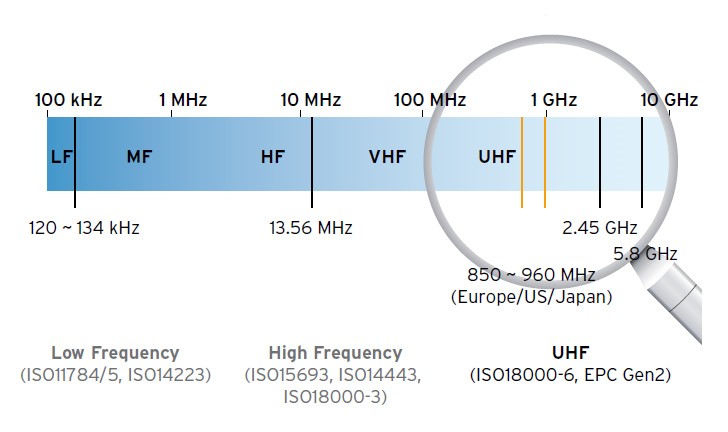
UHF follows the EPCglobal Gen2 standard and uses the 850—960Mhz frequency band to provide fast data transfer rates and much longer read ranges (up to 10m) compared to either LF or HF cards. UHF labels and tags are used extensively in warehousing and goods tracking while UHF cards are popular for location and attendance tracking applications. UHF is negatively affected by materials in the environment such as metals and liquids, but is the best choice for applications that require a long read range and simultaneous reading of a large number of tags. Common UHF chips offered by Cardzgroup include:
Alien Higgs 3: EPC Class1 Gen2 chip with 96—480bit EPC memory, 512bit user memory and 64bit UTID with memory read protection.
Alien Higgs 4: EPC Class1 Gen2 chip with 128bit EPC memory, 128bit user memory and 64bit UTID with memory read protection and pre-encoded with unalterable enterprise-wide serialization scheme.
NXP UCODE 7: EPC Class1 Gen2 chip with 128bit EPC memory and 96bit UTID.
NXP UCODE 7m: EPC Class1 Gen2 chip with 128bit EPC memory, 32bit user memory and 96bit UTID.
NXP UCODE I2C: EPC Class1 Gen2 chip with 160bit EPC memory, 3328bit user memory and 96bit UTID with two independent UHF interfaces and ability to link to I2C interface.
NXP UCODE G2iM: EPC Class1 Gen2 chip with 128-448bit EPC memory, 640-320bit user memory and 96bit UTID with memory read protection and ability to segment memory into open, protected, and private modes. Also has ability to conditionally reduce read range based on activation condition defined by user.
NXP UCODE G2iL: EPC Class1 Gen2 chip with 128bit EPC memory and 64bit UTID with memory read protection.
NXP UCODE G2iL+: EPC Class1 Gen2 chip with 128bit EPC memory and 64bit UTID with memory read protection and tag tamper alarm and ability to conditionally reduce read range based on activation condition defined by user.
Impinj Monza 4D: EPC Class1 Gen2 chip with 128bit EPC memory, 32bit user memory and 96bit UTID with support for omni-directional antennas.
Impinj Monza 4E: EPC Class1 Gen2 chip with up to 496bit EPC memory, 128bit user memory and 96bit serialized TID with support for omni-directional antennas.
Impinj Monza 4QT: EPC Class1 Gen2 chip with 128bit EPC memory, 512bit user memory and 96bit serialized TID with support for omni-directional antennas and ability to create a separate public and private (password protected) data profile on the same chip.
Impinj Monza 5: EPC Class1 Gen2 chip with up to 128bit EPC memory, 32bit user memory and 48bit serialized TID.
Impinj Monza R6: EPC Class1 Gen2 chip with 96bit EPC memory and 48bit serialized TID.
Impinj Monza R6-P: EPC Class1 Gen2 chip with up to 128bit EPC memory, 64bit user memory and 48bit serialized TID.
Impinj Monza S6-C: EPC Class1 Gen2 chip with 96bit EPC memory, 32bit user memory and 48bit serialized TID with one way fail-safe counter for ticketing and metering applications.
Modern applications often call for multiple chips of different frequency to be contained within a single card. The manufacturing challenge is to laminate the chips and antennas in such a way that RF signals will not interfere with one another while still maintaining minimal chip and antenna blemish. Cardzgroup excels in engineering bespoke solutions for any conceivable combination of two or three chips in a single card. Common hybrid card combinations that Cardzgroup supplies include:
Low Frequency + High Frequency: LF + HF cards are the most common dual-frequency cards and usually have an HF antenna laminated around the outside of the card with a thick coil LF antenna contained within. Legacy LF systems like HID prox are often replaced by higher security HF implementations that still require usage of the original LF chip while all sites convert to the newer HF standard.
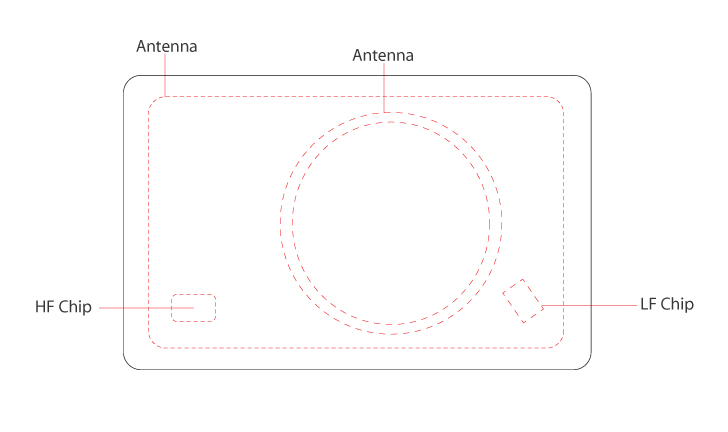
Common HF + LF dual frequency cards offered by Cardzgroup include:
MIFARE® + EM4200
MIFARE® + TK4100
MIFARE® DESFire® + EM4200
MIFARE® DESFire® + TK4100
MIFARE® + T5577
MIFARE® DESFire + T5577
MIFARE® + Hitag
MIFARE® DESFire® + Hitag
High Frequency + Ultra High Frequency: HF + UHF cards are becoming increasingly popular in loyalty and payment schemes that also want to track attendance and location of a customer. These hybrid cards generally have the UHF chip placed separately above or to the side of the HF chip to ensure there is no interference.
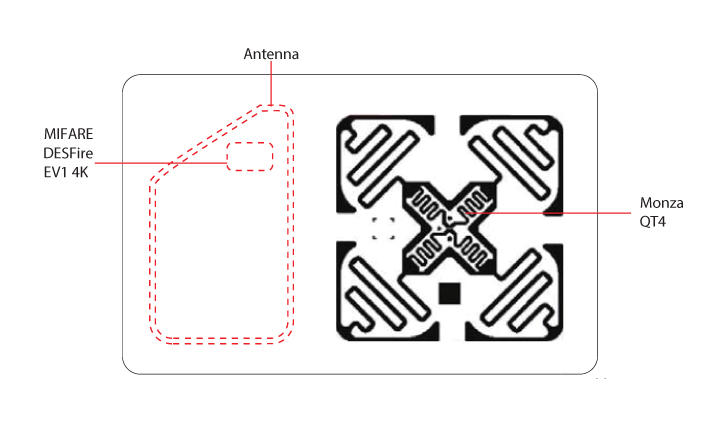
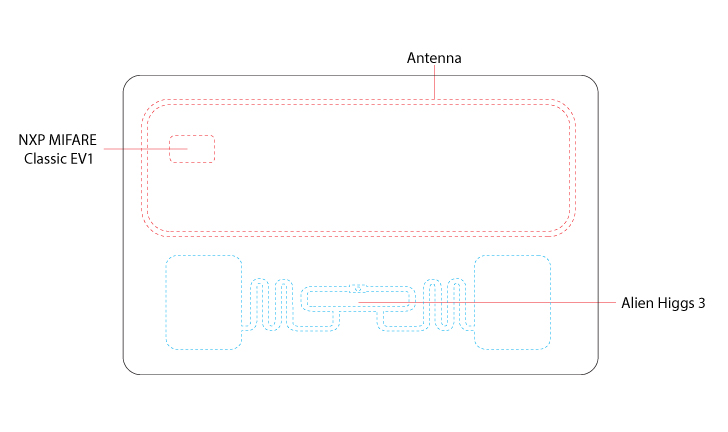
Common HF + UHF dual frequency cards offered by Cardzgroup include:
MIFARE® + Alien Higgs 3
MIFARE® DESFire® + Alien Higgs 3
MIFARE® + Monza 4D
MIFARE® DESFire® + Monza 4D
MIFARE® + Monza 4QT
MIFARE® DESFire® + Monza 4QT
MIFARE® + Ucode 7
MIFARE® DESFire® + Ucode 7
Low Frequency + Ultra High Frequency: LF + UHF cards are used in specialized situations where simple access control is required alongside personnel tracking. Like HF + UHF hybrid cards, LF + UHF is generally accomplished with the LF antenna running above or beside the UHF antenna.
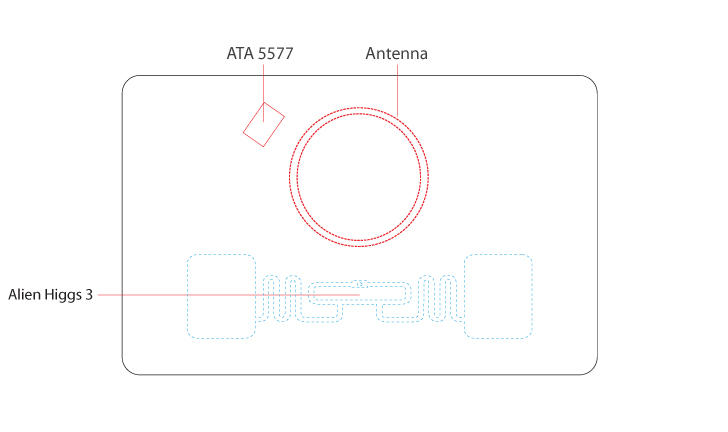
Common LF + UHF dual frequency cards offered by Cardzgroup include:
EM4200 + Alien Higgs 3
TK4100 + Alien Higgs 3
EM4200 + Monza 4QT
TK4100 + Monza 4QT
T5577 + Alien Higgs 3
T5577 + Monza 4QT
MIFARE® is one of the most popular contactless smart card technologies in use, with over 10 billion chips and 150 million
readers having been produced to date. This 13.56Mhz high frequency technology is based on the ISO/IEC 14443A
standard
and is used extensively for payments, transportation, access control, education, and loyalty card schemes amongst
other applications.
MIFARE was developed by Mikron in the early 1990's and stands for MIkron FARE-collection System. It was acquired by
Philips in 1998 which has since spun off to become NXP. The original MIFARE Classic 1k chip was introduced in 1994 and
licensed by Infineon Technologies who produce the Infineon 1k. Over the years, the MIFARE product
family has grown to include a wide range of chips that address the needs of more specialized applications, but the largest
evolution came in 2002 with the introduction of the MIFARE DESFire chip.
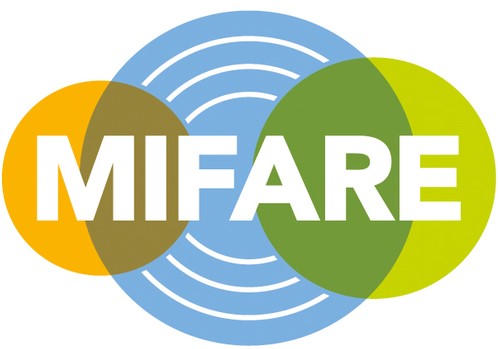
MIFARE DESFire chips contain a full microprocessor that is similar in structure to SmartMX and has much more robust security features compared to MIFARE Classic. While the proprietary Crypto-1 security protocol used in MIFARE Classic has been publicly compromised, the Triple-DES/AES based crypto of MIFARE DESFire EV1 remains secure. This has made MIFARE DESFire EV1 a popular choice
in transportation, payments, and access control applications where security is essential. DESFire Ev2 was announced by NXP in November 2013 and will include applications such as MIsmartApp to allow 3rd party use of memory space without the need
to share secret keys.
Cardzgroup's MIFARE and MIFARE DESFire cards can be found in some of the largest transportation, payments, and loyalty card projects worldwide. We supply printed and personalized MIFARE and MIFARE DESFire cards to over 50 universities and hundreds of globally recognized brands. Cardzgroup supplies the entire MIFARE Classic, MIFARE Plus and MIFARE DESFire product portfolio including:
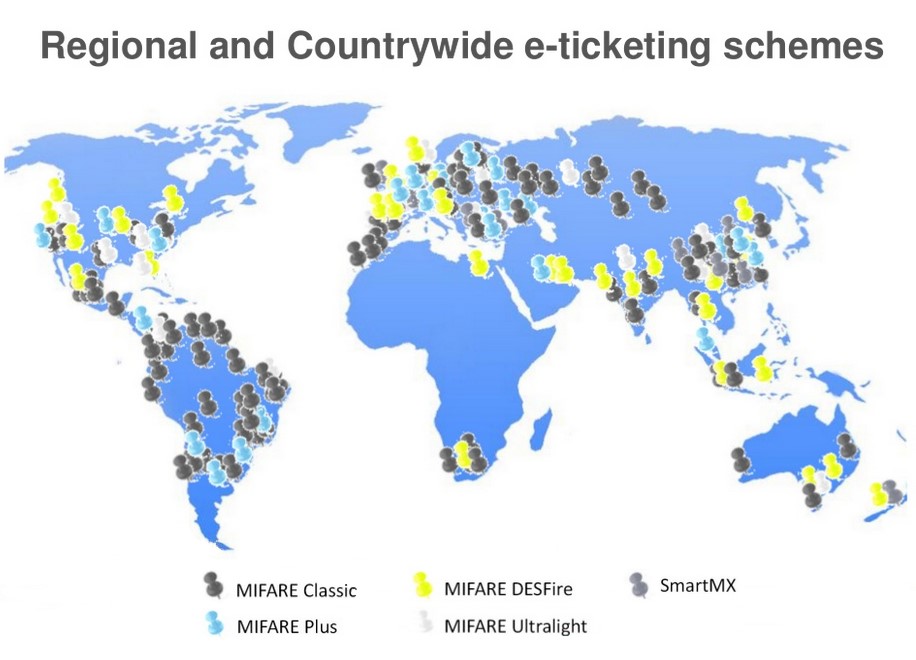
NXP MIFARE Classic 1k: Original MIFARE chip with 1024byte EEPROM and 4-byte / 7-byte UID options. Used in simple ticketing,
loyalty, education and access control applications.
NXP MIFARE Classic EV1 1k: Replacement to the original NXP MIFARE Classic 1k, the newer EV1 version is completely backwards
compatible with all MIFARE Classic 1k systems and contains a digital signature to ensure the chip is a genuine NXP product.
NXP MIFARE Classic 4k: Original MIFARE chip with 4096byte EEPROM and 4-byte / 7-byte UID options. Used in simple ticketing, loyalty, education and access control applications.
NXP MIFARE Classic EV1 4k: Replacement to the original NXP MIFARE Classic 4k, the newer EV1 version is completely backwards compatible with all MIFARE Classic 4k systems and contains a digital signature to ensure the chip is a genuine NXP product.
NXP MIFARE Ultralight: MIFARE chip with 64byte EEPROM, 32bit user definable OTP area and 7-byte UID. Used in disposable transport tickets, event ticketing, and loyalty applications.
NXP MIFARE Ultralight EV1: Replacement to the original NXP MIFARE Ultralight, the newer EV1 version is completely
backwards compatible with all MIFARE Ultralight systems and contains a digital signature to ensure the chip is a genuine NXP product.
NXP MIFARE Ultralight C: MIFARE chip with 192byte EEPROM, 32bit user definable OTP area and 7-byte UID. UL-C is more secure than standard Ultralight as it has 3DES authentication which can be used to secure sections of user memory from write or read/write with a 128bit key. Used in disposable transport tickets, event ticketing, loyalty and prepaid applications.
NXP MIFARE Mini: MIFARE chip with 320byte EEPROM and 4-byte / 7-byte UID options. Used in applications where quick transaction time is more important than large memory size such as public transport, event ticketing, and gaming/loyalty.
MIFARE Plus is based on the same file structure as MIFARE Classic 1k and 4k but Plus gives users the option to use much more secure AES-128 authentication in addition to the weaker Crypto-1 of MIFARE Classic. This means that MIFARE Plus provides an
easy upgrade path for users who are currently using MIFARE Classic but would eventually like to migrate their system to a
higher security option.
The new features that MIFARE Plus offers are:
Virtual Card: Command set that includes function to select one-out-of-many virtual cards that can be emulated by a single NFC device.
Proximity Check: Prevents relay attacks through precision measurement of the time that elapses between a command being sent by the reader and the card's answers.
Security Levels: MIFARE Plus has four distinct security levels that can be chosen. Level 0 is how the chips are delivered from NXP and is the stage of every chip before any personalization has been done. Level 1 uses the same weak security (Crypto-1) as MIFARE Classic and so can be used to replace existing Classic cards without having to replace readers or firmware. Level 2 uses the Crypto-1 communication stream but the encryption keys are generated on the fly by AES-based authentication which in theory combines the security of AES with the speed of Crypto-1. Level 3 uses only AES and is the level at which MIFARE Plus becomes truly secure.
MIFARE Plus is available in two versions, type S and type X:
MIFARE Plus S: stands for "Slim" and is the lightweight version of Plus. It is meant to provide a low-cost and straightforward migration from MIFARE Classic and does not support Security Level 2 or "Proximity Check" with only partial support for the "Virtual Card" scheme.
MIFARE Plus X: stands for "eXpert" and is the full feature version, offering the entire suite of Plus security upgrades and providing more flexibility to optimize the command flow for speed and confidentiality.
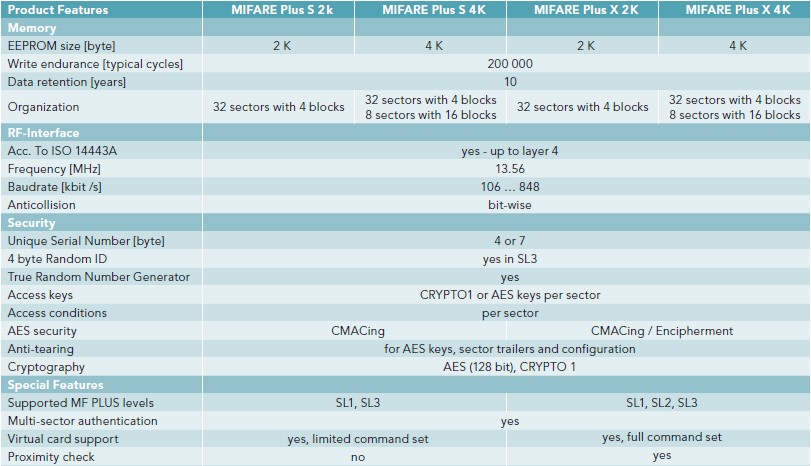
Cardzgroup offers the full range of MIFARE Plus products including:
NXP MIFARE Plus 1k S: Entry level MIFARE Plus upgrade from MIFARE Classic chip with 1024byte EEPROM and 4 byte UID.
NXP MIFARE Plus 2k S: Cost effective MIFARE Plus chip with 2048byte EEPROM and 4 byte / 7 byte UID options.
NXP MIFARE Plus 2k X: Full featured MIFARE Plus chip with 2048byte EEPROM and 4 byte / 7 byte UID options.
NXP MIFARE Plus 4k S: Cost effective MIFARE Plus chip with 4096byte EEPROM and 4 byte / 7 byte UID options.
NXP MIFARE Plus 4k X: Full featured MIFARE Plus chip with 4096byte EEPROM and 4 byte / 7 byte UID options.
MIFARE DESFire cards are meant for applications that require a much higher security level than standard MIFARE products. DESFire provides a highly secure microcontroller-based IC that comes preloaded with NXP's proprietary DESFire operating system, allowing users to take advantage of an on-chip directory structure that can hold up to 28 different applications and 32 files per application. The original DESFire 4k v.06 (MF3ICD40) was discontinued in 2010 and is replaced by the more secure DESFire EV1 version. With DESFire EV1, true 128-bit AES encryption is now standard across all DESFire products, and both hardware and software have been Common Criteria EAL4+ certified.
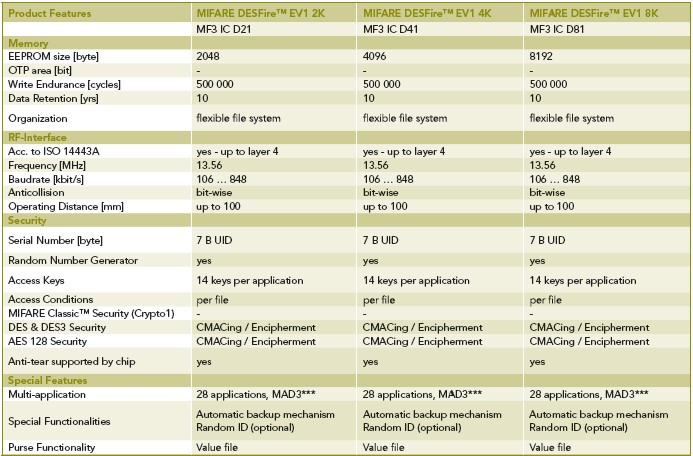
MIFARE DESFire EV1 cards are used extensively in secure payments, transportation and fare collection, education, and access control. Cardzgroup offers the full range of MIFARE DESFire EV1 products including:
NXP MIFARE DESFire EV1 2k: DESFire EV1 chip with 2048byte EEPROM and flexible file system, including automatic backup mechanism and optional Random ID.
NXP MIFARE DESFire EV1 4k: DESFire EV1 chip with 4096byte EEPROM and flexible file system, including automatic backup mechanism and optional Random ID.
NXP MIFARE DESFire EV1 8k: DESFire EV1 chip with 8192byte EEPROM and flexible file system, including automatic backup mechanism and optional Random ID.
*MIFARE and MIFARE Classic are trademarks of NXP B.V.